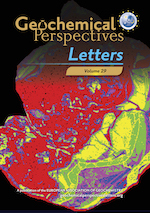Potassium isotope evidence for sediment recycling into the orogenic lithospheric mantle
Affiliations | Corresponding Author | Cite as | Funding information- Share this article





-
Article views:270Cumulative count of HTML views and PDF downloads.
- Download Citation
- Rights & Permissions
top
Abstract
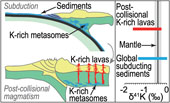
Figures
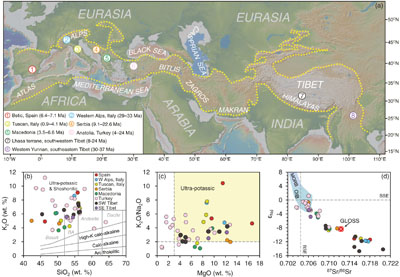 Figure 1 (a) Topographic map (http://www.geomapapp.org / CC BY) showing the region of Alpine-Himalayan orogenic belt (bounded by yellow dashed curves). Numbers in circles refer to the locations of K-rich volcanic rocks investigated in this study. (b) K2O vs. SiO2 diagram for classification of volcanic rocks (Peccerillo and Taylor, 1976). (c) K2O/Na2O vs. MgO. The ultra-potassic field is from Foley et al. (1987). (d) ɛNd vs. 87Sr/86Sr. ɛNd and 87Sr/86Sr were calculated at the eruption age. The average global subducting sediments (GLOSS) is from Plank (2014). Major element and Sr-Nd isotope data as well as corresponding references are provided in Table S-1. | 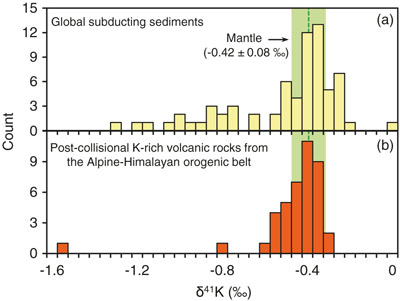 Figure 2 Comparison of δ41K between global subducting sediments (Hu et al., 2020) and K-rich volcanic rocks from the AHOB (this study). The mantle δ41K value (−0.42 ± 0.08 ‰) is from Hu et al. (2021a). | 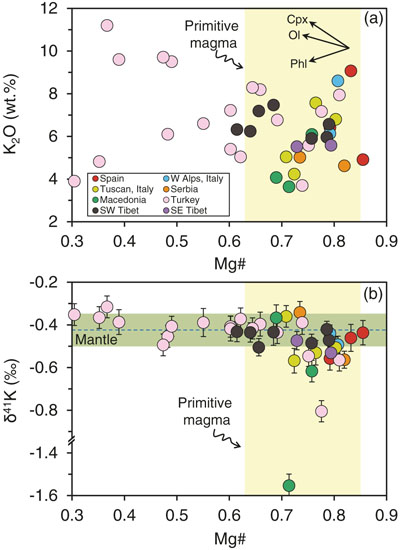 Figure 3 (a) K2O vs. Mg#. The vectors qualitatively indicate evolution of melts during fractional crystallisation of olivine (Ol), clinopyroxene (Cpx) and phlogopite (Phl). The yellow bar refers to the putative Mg# range (0.63–0.85) of primitive magmas, which was calculated based on the forsterite contents (85–95 %) of olivine phenocrysts in K-rich volcanic rocks from the AHOB (Prelević et al., 2013) and the experimentally determined olivine-liquid Fe-Mg exchange coefficient ( | 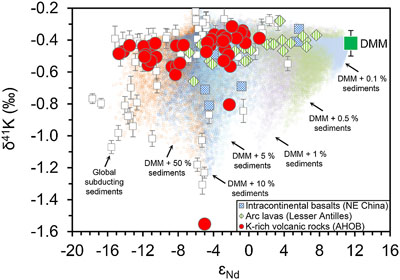 Figure 4 δ41K vs. ɛNd (calculated back at the eruption or depositional age). The δ41K and ɛNd of global subducting sediments are from Hu et al. (2020) and Plank (2014). δ41K of the DMM is assumed to be the average mantle value and ɛNd of the DMM is from Workman and Hart (2005). Small circles with different colours represent random mixing of subducted sediments with the DMM at variable proportions from a Monte Carlo simulation, of which the details are provided in the Supplementary Information. |
| Figure 1 | Figure 2 | Figure 3 | Figure 4 |
top
Introduction
Post-collisional potassic and ultra-potassic volcanic and plutonic rocks contain up to ∼10 wt. % K2O and are one of the most distinctive magmatic types that frequently occurred in global orogenic belts at least since the late Archean (e.g., Couzinié et al., 2016
Couzinié, S., Laurent, O., Moyen, J.-F., Zeh, A., Bouilhol, P., Villaros, A. (2016) Post-collisional magmatism: crustal growth not identified by zircon Hf–O isotopes. Earth and Planetary Science Letters 456, 182–195.
). Their derivation from the mantle is evident from their high MgO contents (>6 wt. %) and Mg# (>0.6), highly forsteritic (Fo85–95) olivine phenocrysts, and the occurrence of mantle xenoliths or xenocrysts entrained by these lavas (e.g., Foley et al., 1987Foley, S., Venturelli, G., Green, D., Toscani, L. (1987) The ultrapotassic rocks: characteristics, classification, and constraints for petrogenetic models. Earth-Science Reviews 24, 81–134.
; Prelević et al., 2013Prelević, D., Jacob, D.E., Foley, S.F. (2013) Recycling plus: a new recipe for the formation of Alpine–Himalayan orogenic mantle lithosphere. Earth and Planetary Science Letters 362, 187–197.
). Despite this, direct partial melting of mantle peridotite is unlikely to generate melts with >2 wt. % K2O (e.g., Walter, 1998Walter, M.J. (1998) Melting of garnet peridotite and the origin of komatiite and depleted lithosphere. Journal of Petrology 39, 29–60.
). These highly potassic lavas are usually enriched in incompatible trace elements, with extreme radiogenic isotopic compositions and trace element patterns resembling those of subducting sediments (e.g., Foley et al., 1987Foley, S., Venturelli, G., Green, D., Toscani, L. (1987) The ultrapotassic rocks: characteristics, classification, and constraints for petrogenetic models. Earth-Science Reviews 24, 81–134.
; Williams et al., 2004Williams, H.M., Turner, S.P., Pearce, J.A., Kelley, S., Harris, N. (2004) Nature of the source regions for post-collisional, potassic magmatism in southern and northern Tibet from geochemical variations and inverse trace element modelling. Journal of Petrology 45, 555–607.
; Prelević et al., 2008Prelević, D., Foley, S.F., Romer, R., Conticelli, S. (2008) Mediterranean Tertiary lamproites derived from multiple source components in postcollisional geodynamics. Geochimica et Cosmochimica Acta 72, 2125–2156.
; Avanzinelli et al., 2009Avanzinelli, R., Lustrino, M., Mattei, M., Melluso, L., Conticelli, S. (2009) Potassic and ultrapotassic magmatism in the circum-Tyrrhenian region: significance of carbonated pelitic vs. pelitic sediment recycling at destructive plate margins. Lithos 113, 213–227.
; Conticelli et al., 2009Conticelli, S., Guarnieri, L., Farinelli, A., Mattei, M., Avanzinelli, R., Bianchini, G., Boari, E., Tommasini, S., Tiepolo, M., Prelević, D. (2009) Trace elements and Sr–Nd–Pb isotopes of K-rich, shoshonitic, and calc-alkaline magmatism of the Western Mediterranean Region: genesis of ultrapotassic to calc-alkaline magmatic associations in a post-collisional geodynamic setting. Lithos 107, 68–92.
; Zhao et al., 2009Zhao, Z., Mo, X., Dilek, Y., Niu, Y., DePaolo, D.J., Robinson, P., Zhu, D., Sun, C., Dong, G., Zhou, S. (2009) Geochemical and Sr–Nd–Pb–O isotopic compositions of the post-collisional ultrapotassic magmatism in SW Tibet: petrogenesis and implications for India intra-continental subduction beneath southern Tibet. Lithos 113, 190–212.
; Couzinié et al., 2016Couzinié, S., Laurent, O., Moyen, J.-F., Zeh, A., Bouilhol, P., Villaros, A. (2016) Post-collisional magmatism: crustal growth not identified by zircon Hf–O isotopes. Earth and Planetary Science Letters 456, 182–195.
). These features indicate that the recycling of continent-derived sediments into their mantle sources contributes to the peculiar K enrichment in these lavas. However, correlated relationships between K enrichment and common indices of sediment contribution in highly potassic lavas such as Th/La, Sm/La, Th/Nb, Hf/Sm and radiogenic isotopes (e.g., Sr, Nd, Pb, and Os) are rarely observed (Tommasini et al., 2011Tommasini, S., Avanzinelli, R., Conticelli, S. (2011) The Th/La and Sm/La conundrum of the Tethyan realm lamproites. Earth and Planetary Science Letters 301, 469–478.
; Prelević et al., 2013Prelević, D., Jacob, D.E., Foley, S.F. (2013) Recycling plus: a new recipe for the formation of Alpine–Himalayan orogenic mantle lithosphere. Earth and Planetary Science Letters 362, 187–197.
). This decoupled behaviour might reflect that (1) the budget of Th, Nb, Hf and REE in sediments is dominated by accessory minerals (e.g., epidote, rutile and zircon) barely accommodating K, and (2) radiogenic isotopic compositions depend on age and time-integrated parent/daughter ratio, unrelated to K abundance in sediments.Recent developments in high precision K isotopic analysis (≤0.06 ‰) revealed large K isotopic variation (∼1.3 ‰) in sediments, which has been ascribed to low temperature processes such as chemical weathering or diagenesis (Li et al., 2019
Li, S., Li, W., Beard, B.L., Raymo, M.E., Wang, X., Chen, Y., Chen, J. (2019) K isotopes as a tracer for continental weathering and geological K cycling. Proceedings of the National Academy of Sciences 116, 8740–8745.
; Chen et al., 2020Chen, H., Liu, X.-M., Wang, K. (2020) Potassium isotope fractionation during chemical weathering of basalts. Earth and Planetary Science Letters 539, 116192.
; Hu et al., 2020Hu, Y., Teng, F.-Z., Plank, T., Chauvel, C. (2020) Potassium isotopic heterogeneity in subducting oceanic plates. Science Advances 6, eabb2472.
; Huang et al., 2020Huang, T.-Y., Teng, F.-Z., Rudnick, R.L., Chen, X.-Y., Hu, Y., Liu, Y.-S., Wu, F.-Y. (2020) Heterogeneous potassium isotopic composition of the upper continental crust. Geochimica et Cosmochimica Acta 278, 122–136.
; Santiago Ramos et al., 2020Santiago Ramos, D.P., Coogan, L.A., Murphy, J.G., Higgins, J.A. (2020) Low-temperature oceanic crust alteration and the isotopic budgets of potassium and magnesium in seawater. Earth and Planetary Science Letters 541, 116290.
; Teng et al., 2020Teng, F.-Z., Hu, Y., Ma, J.-L., Wei, G.-J., Rudnick, R.L. (2020) Potassium isotope fractionation during continental weathering and implications for global K isotopic balance. Geochimica et Cosmochimica Acta 278, 261–271.
). By contrast, high temperature magmatic processes do not significantly fractionate K isotopes (Tuller-Ross et al., 2019aTuller-Ross, B., Marty, B., Chen, H., Kelley, K.A., Lee, H., Wang, K. (2019a) Potassium isotope systematics of oceanic basalts. Geochimica et Cosmochimica Acta 259, 144–154.
,bTuller-Ross, B., Savage, P.S., Chen, H., Wang, K. (2019b) Potassium isotope fractionation during magmatic differentiation of basalt to rhyolite. Chemical Geology 525, 37–45.
; Hu et al., 2021aHu, Y., Teng, F.Z., Helz, R.T., Chauvel, C. (2021a) Potassium isotope fractionation during magmatic differentiation and the composition of the mantle. Journal of Geophysical Research: Solid Earth 126, e2020JB021543.
). Hence, potassium isotopes can potentially be used to trace sedimentary K in mantle-derived melts, which has been recently applied to explain the K isotopic variations in intracontinental basalts from northeast China (Sun et al., 2020Sun, Y., Teng, F.-Z., Hu, Y., Chen, X.-Y., Pang, K.-N. (2020) Tracing subducted oceanic slabs in the mantle by using potassium isotopes. Geochimica et Cosmochimica Acta 278, 353–360.
) and arc lavas from Lesser Antilles (Hu et al., 2021bHu, Y., Teng, F.-Z., Chauvel, C. (2021b) Potassium isotopic evidence for sedimentary input to the mantle source of Lesser Antilles lavas. Geochimica et Cosmochimica Acta 295, 98–111.
).Here we report the first comprehensive K isotope dataset for representative post-collisional K-rich lavas from eight regions within the Cenozoic Alpine-Himalayan orogenic belt (AHOB; Fig. 1a). These samples are well characterised for their petrology, mineralogy, major, trace element, and radiogenic isotope geochemistry (Prelević et al., 2005
Prelević, D., Foley, S.F., Romer, R.L., Cvetković, V., Downes, H. (2005) Tertiary ultrapotassic volcanism in Serbia: constraints on petrogenesis and mantle source characteristics. Journal of Petrology 46, 1443–1487.
, 2008Prelević, D., Foley, S.F., Romer, R., Conticelli, S. (2008) Mediterranean Tertiary lamproites derived from multiple source components in postcollisional geodynamics. Geochimica et Cosmochimica Acta 72, 2125–2156.
, 2012Prelević, D., Akal, C., Foley, S.F., Romer, R.L., Stracke, A., Van Den Bogaard, P. (2012) Ultrapotassic mafic rocks as geochemical proxies for post-collisional dynamics of orogenic lithospheric mantle: the case of southwestern Anatolia, Turkey. Journal of Petrology 53, 1019–1055.
, 2015Prelević, D., Akal, C., Romer, R.L., Mertz-Kraus, R., Helvacı, C. (2015) Magmatic response to slab tearing: constraints from the Afyon Alkaline Volcanic Complex, Western Turkey. Journal of Petrology 56, 527–562.
; Zhao et al., 2009Zhao, Z., Mo, X., Dilek, Y., Niu, Y., DePaolo, D.J., Robinson, P., Zhu, D., Sun, C., Dong, G., Zhou, S. (2009) Geochemical and Sr–Nd–Pb–O isotopic compositions of the post-collisional ultrapotassic magmatism in SW Tibet: petrogenesis and implications for India intra-continental subduction beneath southern Tibet. Lithos 113, 190–212.
; S.-A. Liu et al., 2020Liu, S.A., Wang, Z.Z., Yang, C., Li, S.G., Ke, S. (2020) Mg and Zn isotope evidence for two types of mantle metasomatism and deep recycling of magnesium carbonates. Journal of Geophysical Research: Solid Earth, e2020JB020684.
). They cover major types of K-rich volcanic rocks, ranging from lamproite, shoshonite, high-K calc-alkaline basalt-andesite to leucite-bearing silica undersaturated rock (leucitite, melilite, and ugandite), and span a wide range of K2O contents from 3.6 to 11.2 wt. % and K2O/Na2O from 1.1 to 10.4, of which the majority are ultra-potassic (Fig. 1b,c). All samples have trace element patterns resembling upper crustal materials (Fig. S-1) and display a range of Sr and Nd isotopic ratios from OIB-like to continental crust-like (Fig. 1d). Our study finds large K isotopic variation in these K-rich rocks, comparable to subducting sediments, supporting recycling of sediments into the mantle wedge beneath accretionary orogens.
Figure 1 (a) Topographic map (http://www.geomapapp.org / CC BY) showing the region of Alpine-Himalayan orogenic belt (bounded by yellow dashed curves). Numbers in circles refer to the locations of K-rich volcanic rocks investigated in this study. (b) K2O vs. SiO2 diagram for classification of volcanic rocks (Peccerillo and Taylor, 1976
Peccerillo, A., Taylor, S. (1976) Geochemistry of Eocene calc-alkaline volcanic rocks from the Kastamonu area, northern Turkey. Contributions to Mineralogy and Petrology 58, 63–81.
). (c) K2O/Na2O vs. MgO. The ultra-potassic field is from Foley et al. (1987)Foley, S., Venturelli, G., Green, D., Toscani, L. (1987) The ultrapotassic rocks: characteristics, classification, and constraints for petrogenetic models. Earth-Science Reviews 24, 81–134.
. (d) ɛNd vs. 87Sr/86Sr. ɛNd and 87Sr/86Sr were calculated at the eruption age. The average global subducting sediments (GLOSS) is from Plank (2014)Plank, T. (2014) 4.17 – The chemical composition of subducting sediments. In: Holland, H.D., Turekian, K.K. (Eds.) Treatise on Geochemistry. Second Edition, Elsevier, Oxford, 607–629.
. Major element and Sr-Nd isotope data as well as corresponding references are provided in Table S-1.top
Potassium Isotope Systematics of K-rich Volcanic Rocks
δ41K of all samples vary from −1.55 ‰ to −0.32 ‰, mimicking the range of global subducting sediments (δ41K = −1.30 ‰ to −0.02 ‰; Hu et al., 2020
Hu, Y., Teng, F.-Z., Plank, T., Chauvel, C. (2020) Potassium isotopic heterogeneity in subducting oceanic plates. Science Advances 6, eabb2472.
) (Fig. 2). Two lamproites from Macedonia and Turkey have the lowest δ41K (−1.55 ± 0.05 ‰ and −0.80 ± 0.05 ‰) reported for mantle-derived lavas. δ41K of the other 39 samples range from −0.62 ± 0.05 ‰ to −0.32 ± 0.05 ‰, which greatly exceeds our analytical precision (≤0.06 ‰). To date, high precision δ41K value of the mantle is not well constrained due to the large analytical uncertainties of previous studies (Tuller-Ross et al., 2019aTuller-Ross, B., Marty, B., Chen, H., Kelley, K.A., Lee, H., Wang, K. (2019a) Potassium isotope systematics of oceanic basalts. Geochimica et Cosmochimica Acta 259, 144–154.
). Nonetheless, the most recent study suggested an average mantle δ41K of −0.42 ± 0.08 ‰ (2 s.d.; Hu et al., 2021aHu, Y., Teng, F.Z., Helz, R.T., Chauvel, C. (2021a) Potassium isotope fractionation during magmatic differentiation and the composition of the mantle. Journal of Geophysical Research: Solid Earth 126, e2020JB021543.
) and significant numbers of lamproites and shoshonites investigated in this study have resolvably lower δ41K compared to this mantle value.
Figure 2 Comparison of δ41K between global subducting sediments (Hu et al., 2020
Hu, Y., Teng, F.-Z., Plank, T., Chauvel, C. (2020) Potassium isotopic heterogeneity in subducting oceanic plates. Science Advances 6, eabb2472.
) and K-rich volcanic rocks from the AHOB (this study). The mantle δ41K value (−0.42 ± 0.08 ‰) is from Hu et al. (2021a)Hu, Y., Teng, F.Z., Helz, R.T., Chauvel, C. (2021a) Potassium isotope fractionation during magmatic differentiation and the composition of the mantle. Journal of Geophysical Research: Solid Earth 126, e2020JB021543.
.Post-eruption alteration processes cannot account for the large K isotopic variation in our samples since correlation between δ41K and loss on ignition (LOI) is lacking and the isotopically lightest samples have very low LOI (Fig. S-2). Potassium isotope fractionation during partial melting of the mantle and differentiation of mafic magmas is limited and only highly differentiated, Mg-depleted melts have slightly lower δ41K than primitive melts (Tuller-Ross et al., 2019b
Tuller-Ross, B., Savage, P.S., Chen, H., Wang, K. (2019b) Potassium isotope fractionation during magmatic differentiation of basalt to rhyolite. Chemical Geology 525, 37–45.
; Hu et al., 2021aHu, Y., Teng, F.Z., Helz, R.T., Chauvel, C. (2021a) Potassium isotope fractionation during magmatic differentiation and the composition of the mantle. Journal of Geophysical Research: Solid Earth 126, e2020JB021543.
). The absence of correlation between δ41K and indices of differentiation such as Mg#, SiO2 and K2O in our samples further confirms this (Figs. 3b, S-3). More importantly, low δ41K values are only observed in samples with Mg# > 0.7 (Fig. 3b), which have been commonly considered as primary or near-primary melts that suffered limited differentiation and crustal contamination (Prelević et al., 2013Prelević, D., Jacob, D.E., Foley, S.F. (2013) Recycling plus: a new recipe for the formation of Alpine–Himalayan orogenic mantle lithosphere. Earth and Planetary Science Letters 362, 187–197.
). Therefore, K isotopic variation in these K-rich lavas most likely reflects source heterogeneity.
Figure 3 (a) K2O vs. Mg#. The vectors qualitatively indicate evolution of melts during fractional crystallisation of olivine (Ol), clinopyroxene (Cpx) and phlogopite (Phl). The yellow bar refers to the putative Mg# range (0.63–0.85) of primitive magmas, which was calculated based on the forsterite contents (85–95 %) of olivine phenocrysts in K-rich volcanic rocks from the AHOB (Prelević et al., 2013
Prelević, D., Jacob, D.E., Foley, S.F. (2013) Recycling plus: a new recipe for the formation of Alpine–Himalayan orogenic mantle lithosphere. Earth and Planetary Science Letters 362, 187–197.
) and the experimentally determined olivine-liquid Fe-Mg exchange coefficient ( = 0.3; Roeder and Emslie, 1970
= 0.3; Roeder and Emslie, 1970Roeder, P.L., Emslie, R. (1970) Olivine-liquid equilibrium. Contributions to Mineralogy and Petrology 29, 275–289.
). (b) δ41K vs. Mg#. The mantle δ41K (−0.42 ± 0.08 ‰) is from Hu et al. (2021a)Hu, Y., Teng, F.Z., Helz, R.T., Chauvel, C. (2021a) Potassium isotope fractionation during magmatic differentiation and the composition of the mantle. Journal of Geophysical Research: Solid Earth 126, e2020JB021543.
.top
Potassium Isotope Heterogeneity in Mantle Sources
Altered oceanic crust (AOC) and sediments dominate the K budget in subducting slabs, which may lead to K isotope heterogeneity in the mantle (Hu et al., 2020
Hu, Y., Teng, F.-Z., Plank, T., Chauvel, C. (2020) Potassium isotopic heterogeneity in subducting oceanic plates. Science Advances 6, eabb2472.
). δ41K of the AOC range from −1.07 ‰ to +0.01 ‰, and hence incorporation of recycled AOC in the mantle can potentially explain the heterogeneous δ41K in our samples (Hu et al., 2020Hu, Y., Teng, F.-Z., Plank, T., Chauvel, C. (2020) Potassium isotopic heterogeneity in subducting oceanic plates. Science Advances 6, eabb2472.
; Santiago Ramos et al., 2020Santiago Ramos, D.P., Coogan, L.A., Murphy, J.G., Higgins, J.A. (2020) Low-temperature oceanic crust alteration and the isotopic budgets of potassium and magnesium in seawater. Earth and Planetary Science Letters 541, 116290.
). However, the AOC is characterised by MORB-like positive ɛNd (Staudigel et al., 1995Staudigel, H., Davies, G.R., Hart, S.R., Marchant, K.M., Smith, B.M. (1995) Large scale isotopic Sr, Nd and O isotopic anatomy of altered oceanic crust: DSDP/ODP sites 417/418. Earth and Planetary Science Letters 130, 169–185.
), inconsistent with the negative ɛNd of the K-rich volcanic rocks (Fig. 1d). Fluids released from subducting oceanic mafic crust were inferred to have higher δ41K (0.13 ‰ to 1.37 ‰) than the mantle (H. Liu et al., 2020Liu, S.A., Wang, Z.Z., Yang, C., Li, S.G., Ke, S. (2020) Mg and Zn isotope evidence for two types of mantle metasomatism and deep recycling of magnesium carbonates. Journal of Geophysical Research: Solid Earth, e2020JB020684.
), and hence cannot result in the low δ41K in our samples. Subducting sediments characterised by variable and negative ɛNd are most likely to be the K source (Fig. 4). Limited K isotope fractionation in subducting sediments occurs during prograde metamorphic dehydration (Wang et al., 2021Wang, Z.-Z, Teng, F.-Z., Busigny, V., Liu, S.-A. (2021) Evidence from HP/UHP metasediments for subduction of isotopically heterogeneous potassium into the mantle. American Mineralogist in press. doi: 10.2138/am-2021-7923.
). Therefore, K isotopic signatures of subducting sediments could be transferred to the mantle source of K-rich lavas.
Figure 4 δ41K vs. ɛNd (calculated back at the eruption or depositional age). The δ41K and ɛNd of global subducting sediments are from Hu et al. (2020)
Hu, Y., Teng, F.-Z., Plank, T., Chauvel, C. (2020) Potassium isotopic heterogeneity in subducting oceanic plates. Science Advances 6, eabb2472.
and Plank (2014)Plank, T. (2014) 4.17 – The chemical composition of subducting sediments. In: Holland, H.D., Turekian, K.K. (Eds.) Treatise on Geochemistry. Second Edition, Elsevier, Oxford, 607–629.
. δ41K of the DMM is assumed to be the average mantle value and ɛNd of the DMM is from Workman and Hart (2005)Workman, R.K., Hart, S.R. (2005) Major and trace element composition of the depleted MORB mantle (DMM). Earth and Planetary Science Letters 231, 53–72.
. Small circles with different colours represent random mixing of subducted sediments with the DMM at variable proportions from a Monte Carlo simulation, of which the details are provided in the Supplementary Information.Heavy K isotopes were preferentially released into hydrosphere during continental weathering, leaving the residues enriched in light K isotopes (Li et al., 2019
Li, S., Li, W., Beard, B.L., Raymo, M.E., Wang, X., Chen, Y., Chen, J. (2019) K isotopes as a tracer for continental weathering and geological K cycling. Proceedings of the National Academy of Sciences 116, 8740–8745.
; Chen et al., 2020Chen, H., Liu, X.-M., Wang, K. (2020) Potassium isotope fractionation during chemical weathering of basalts. Earth and Planetary Science Letters 539, 116192.
; Teng et al., 2020Teng, F.-Z., Hu, Y., Ma, J.-L., Wei, G.-J., Rudnick, R.L. (2020) Potassium isotope fractionation during continental weathering and implications for global K isotopic balance. Geochimica et Cosmochimica Acta 278, 261–271.
). Terrigenous sediments that underwent moderate to intensive weathering display a range of δ41K from −0.70 ‰ to −0.35 ‰ (Hu et al., 2020Hu, Y., Teng, F.-Z., Plank, T., Chauvel, C. (2020) Potassium isotopic heterogeneity in subducting oceanic plates. Science Advances 6, eabb2472.
), covering δ41K of all but two of our samples. Incorporation of K into authigenic clay minerals during diagenesis strongly favours light K isotopes, producing sediments with δ41K down to −1.31 ‰ (Hu et al., 2020Hu, Y., Teng, F.-Z., Plank, T., Chauvel, C. (2020) Potassium isotopic heterogeneity in subducting oceanic plates. Science Advances 6, eabb2472.
), which approaches the lowest value of our samples. Therefore, recycled authigenic clay-rich sediments, which are difficult to identify by trace elements and radiogenic isotopes, likely contribute to K in the two lamproites with extremely low δ41K. The scarcity of such samples is also consistent with the low fractions of isotopically light clay-rich sediments in global subducting sediments (Fig. 2). In addition, these low δ41K lamproites mainly occur in the eastern Mediterranean provinces (Serbia, Macedonia, and Turkey) and are characterised by less radiogenic Sr and unradiogenic Nd isotopic signatures compared to the western Mediterranean counterparts (Spain and Italy), which reflects involvement of sediments with different age and provenance in their sources (Prelević et al., 2008Prelević, D., Foley, S.F., Romer, R., Conticelli, S. (2008) Mediterranean Tertiary lamproites derived from multiple source components in postcollisional geodynamics. Geochimica et Cosmochimica Acta 72, 2125–2156.
). The distinct K isotopic feature between samples from these two provinces further indicates regional heterogeneity in δ41K of recycled sediments.A Monte Carlo mixing model between the DMM (depleted MORB mantle) and subducted sediments shows that the addition of up to 5 % sediment in the mantle can almost reproduce the full range of δ41K in these K-rich volcanic rocks because of the much higher K content in sediments than in the mantle (Fig. 4). The actual amount of sediment may be much lower considering that sediment melts, which are more enriched in incompatible elements than bulk sediments, were most likely added into the mantle. The sediment fraction derived above is significantly lower than that used in partial melting experiments on a mixture of peridotite and sediment or sediment-derived melt to generate ultra-potassic melts (≥25 %; Mallik et al., 2015
Mallik, A., Nelson, J., Dasgupta, R. (2015) Partial melting of fertile peridotite fluxed by hydrous rhyolitic melt at 2–3 GPa: implications for mantle wedge hybridization by sediment melt and generation of ultrapotassic magmas in convergent margins. Contributions to Mineralogy and Petrology 169, 48.
; Förster et al., 2020Förster, M.W., Buhre, S., Xu, B., Prelević, D., Mertz-Kraus, R., Foley, S.F. (2020) Two-stage origin of K-enrichment in ultrapotassic magmatism simulated by melting of experimentally metasomatized mantle. Minerals 10, 41.
). Therefore, if the experimental amount of sediment is employed in our model, δ41K of ultra-potassic melts will completely inherit those of recycled sediments. Overall, recycling of a small amount of isotopically anomalous sediments into the mantle can significantly modify δ41K of the mantle. This process can adequately explain the large variations of δ41K and especially low δ41K that are often observed in isotopically “enriched” (i.e. low ɛNd) mantle-derived melts erupted in various tectonic settings (Fig. 4). Therefore, K isotopes may become one of the most sensitive indicators for the presence of sediments in the mantle.top
Acknowledgements
We are grateful to Xin-Yang Chen, Yan Hu, Tian-Yi Huang, Pete Wynn and Kai-Chen Xing for their help during K isotopic analysis. Constructive comments from Dr. Oscar Laurent, one anonymous reviewer and the editor Dr. Maud Boyet are highly appreciated. This work is financially supported by the National Key R&D Program of China (2019YFA0708400) and the Programme of Introducing Talents of Discipline to Universities (i.e. the 111 project; B18048) to S.-A. Liu.
Editor: Maud Boyet
top
References
Avanzinelli, R., Lustrino, M., Mattei, M., Melluso, L., Conticelli, S. (2009) Potassic and ultrapotassic magmatism in the circum-Tyrrhenian region: significance of carbonated pelitic vs. pelitic sediment recycling at destructive plate margins. Lithos 113, 213–227.
 Show in context
Show in contextThese highly potassic lavas are usually enriched in incompatible trace elements, with extreme radiogenic isotopic compositions and trace element patterns resembling those of subducting sediments (e.g., Foley et al., 1987; Williams et al., 2004; Prelević et al., 2008; Avanzinelli et al., 2009; Conticelli et al., 2009; Zhao et al., 2009; Couzinié et al., 2016).
View in article
Chen, H., Liu, X.-M., Wang, K. (2020) Potassium isotope fractionation during chemical weathering of basalts. Earth and Planetary Science Letters 539, 116192.
 Show in context
Show in contextRecent developments in high precision K isotopic analysis (≤0.06 ‰) revealed large K isotopic variation (∼1.3 ‰) in sediments, which has been ascribed to low temperature processes such as chemical weathering or diagenesis (Li et al., 2019; Chen et al., 2020; Hu et al., 2020; Huang et al., 2020; Santiago Ramos et al., 2020; Teng et al., 2020).
View in article
Heavy K isotopes were preferentially released into hydrosphere during continental weathering, leaving the residues enriched in light K isotopes (Li et al., 2019; Chen et al., 2020; Teng et al., 2020).
View in article
Conticelli, S., Guarnieri, L., Farinelli, A., Mattei, M., Avanzinelli, R., Bianchini, G., Boari, E., Tommasini, S., Tiepolo, M., Prelević, D. (2009) Trace elements and Sr–Nd–Pb isotopes of K-rich, shoshonitic, and calc-alkaline magmatism of the Western Mediterranean Region: genesis of ultrapotassic to calc-alkaline magmatic associations in a post-collisional geodynamic setting. Lithos 107, 68–92.
 Show in context
Show in contextThese highly potassic lavas are usually enriched in incompatible trace elements, with extreme radiogenic isotopic compositions and trace element patterns resembling those of subducting sediments (e.g., Foley et al., 1987; Williams et al., 2004; Prelević et al., 2008; Avanzinelli et al., 2009; Conticelli et al., 2009; Zhao et al., 2009; Couzinié et al., 2016).
View in article
Couzinié, S., Laurent, O., Moyen, J.-F., Zeh, A., Bouilhol, P., Villaros, A. (2016) Post-collisional magmatism: crustal growth not identified by zircon Hf–O isotopes. Earth and Planetary Science Letters 456, 182–195.
 Show in context
Show in contextPost-collisional potassic and ultra-potassic volcanic and plutonic rocks contain up to ∼10 wt. % K2O and are one of the most distinctive magmatic types that frequently occurred in global orogenic belts at least since the late Archean (e.g., Couzinié et al., 2016).
View in article
These highly potassic lavas are usually enriched in incompatible trace elements, with extreme radiogenic isotopic compositions and trace element patterns resembling those of subducting sediments (e.g., Foley et al., 1987; Williams et al., 2004; Prelević et al., 2008; Avanzinelli et al., 2009; Conticelli et al., 2009; Zhao et al., 2009; Couzinié et al., 2016).
View in article
Foley, S., Venturelli, G., Green, D., Toscani, L. (1987) The ultrapotassic rocks: characteristics, classification, and constraints for petrogenetic models. Earth-Science Reviews 24, 81–134.
 Show in context
Show in contextTheir derivation from the mantle is evident from their high MgO contents (>6 wt. %) and Mg# (>0.6), highly forsteritic (Fo85–95) olivine phenocrysts, and the occurrence of mantle xenoliths or xenocrysts entrained by these lavas (e.g., Foley et al., 1987; Prelević et al., 2013).
View in article
(c) K2O/Na2O vs. MgO. The ultra-potassic field is from Foley et al. (1987).
View in article
These highly potassic lavas are usually enriched in incompatible trace elements, with extreme radiogenic isotopic compositions and trace element patterns resembling those of subducting sediments (e.g., Foley et al., 1987; Williams et al., 2004; Prelević et al., 2008; Avanzinelli et al., 2009; Conticelli et al., 2009; Zhao et al., 2009; Couzinié et al., 2016).
View in article
Förster, M.W., Buhre, S., Xu, B., Prelević, D., Mertz-Kraus, R., Foley, S.F. (2020) Two-stage origin of K-enrichment in ultrapotassic magmatism simulated by melting of experimentally metasomatized mantle. Minerals 10, 41.
 Show in context
Show in contextThe sediment fraction derived above is significantly lower than that used in partial melting experiments on a mixture of peridotite and sediment or sediment-derived melt to generate ultra-potassic melts (≥25 %; Mallik et al., 2015; Förster et al., 2020).
View in article
Hu, Y., Teng, F.-Z., Plank, T., Chauvel, C. (2020) Potassium isotopic heterogeneity in subducting oceanic plates. Science Advances 6, eabb2472.
 Show in context
Show in contextδ41K of all samples vary from −1.55 ‰ to −0.32 ‰, mimicking the range of global subducting sediments (δ41K = −1.30 ‰ to −0.02 ‰; Hu et al., 2020) (Fig. 2).
View in article
Comparison of δ41K between global subducting sediments (Hu et al., 2020) and K-rich volcanic rocks from the AHOB (this study). The mantle δ41K value (−0.42 ± 0.08 ‰) is from Hu et al. (2021a).
View in article
Altered oceanic crust (AOC) and sediments dominate the K budget in subducting slabs, which may lead to K isotope heterogeneity in the mantle (Hu et al., 2020).
View in article
δ41K of the AOC range from −1.07 ‰ to +0.01 ‰, and hence incorporation of recycled AOC in the mantle can potentially explain the heterogeneous δ41K in our samples (Hu et al., 2020; Santiago Ramos et al., 2020).
View in article
The δ41K and ɛNd of global subducting sediments are from Hu et al. (2020) and Plank (2014).
View in article
Terrigenous sediments that underwent moderate to intensive weathering display a range of δ41K from −0.70 ‰ to −0.35 ‰ (Hu et al., 2020), covering δ41K of all but two of our samples.
View in article
Incorporation of K into authigenic clay minerals during diagenesis strongly favours light K isotopes, producing sediments with δ41K down to −1.31 ‰ (Hu et al., 2020), which approaches the lowest value of our samples. Therefore, recycled authigenic clay-rich sediments, which are difficult to identify by trace elements and radiogenic isotopes, likely contribute to K in the two lamproites with extremely low δ41K.
View in article
Recent developments in high precision K isotopic analysis (≤0.06 ‰) revealed large K isotopic variation (∼1.3 ‰) in sediments, which has been ascribed to low temperature processes such as chemical weathering or diagenesis (Li et al., 2019; Chen et al., 2020; Hu et al., 2020; Huang et al., 2020; Santiago Ramos et al., 2020; Teng et al., 2020).
View in article
Hu, Y., Teng, F.Z., Helz, R.T., Chauvel, C. (2021a) Potassium isotope fractionation during magmatic differentiation and the composition of the mantle. Journal of Geophysical Research: Solid Earth 126, e2020JB021543.
 Show in context
Show in contextNonetheless, the most recent study suggested an average mantle δ41K of −0.42 ± 0.08 ‰ (2 s.d.; Hu et al., 2021a) and significant numbers of lamproites and shoshonites investigated in this study have resolvably lower δ41K compared to this mantle value.
View in article
Comparison of δ41K between global subducting sediments (Hu et al., 2020) and K-rich volcanic rocks from the AHOB (this study). The mantle δ41K value (−0.42 ± 0.08 ‰) is from Hu et al. (2021a).
View in article
Potassium isotope fractionation during partial melting of the mantle and differentiation of mafic magmas is limited and only highly differentiated, Mg-depleted melts have slightly lower δ41K than primitive melts (Tuller-Ross et al., 2019b; Hu et al., 2021a).
View in article
(b) δ41K vs. Mg#. The mantle δ41K (−0.42 ± 0.08 ‰) is from Hu et al. (2021a).
View in article
By contrast, high temperature magmatic processes do not significantly fractionate K isotopes (Tuller-Ross et al., 2019a,b; Hu et al., 2021a).
View in article
Hu, Y., Teng, F.-Z., Chauvel, C. (2021b) Potassium isotopic evidence for sedimentary input to the mantle source of Lesser Antilles lavas. Geochimica et Cosmochimica Acta 295, 98–111.
 Show in context
Show in contextHence, potassium isotopes can potentially be used to trace sedimentary K in mantle-derived melts, which has been recently applied to explain the K isotopic variations in intracontinental basalts from northeast China (Sun et al., 2020) and arc lavas from Lesser Antilles (Hu et al., 2021b).
View in article
Huang, T.-Y., Teng, F.-Z., Rudnick, R.L., Chen, X.-Y., Hu, Y., Liu, Y.-S., Wu, F.-Y. (2020) Heterogeneous potassium isotopic composition of the upper continental crust. Geochimica et Cosmochimica Acta 278, 122–136.
 Show in context
Show in contextRecent developments in high precision K isotopic analysis (≤0.06 ‰) revealed large K isotopic variation (∼1.3 ‰) in sediments, which has been ascribed to low temperature processes such as chemical weathering or diagenesis (Li et al., 2019; Chen et al., 2020; Hu et al., 2020; Huang et al., 2020; Santiago Ramos et al., 2020; Teng et al., 2020).
View in article
Li, S., Li, W., Beard, B.L., Raymo, M.E., Wang, X., Chen, Y., Chen, J. (2019) K isotopes as a tracer for continental weathering and geological K cycling. Proceedings of the National Academy of Sciences 116, 8740–8745.
 Show in context
Show in contextRecent developments in high precision K isotopic analysis (≤0.06 ‰) revealed large K isotopic variation (∼1.3 ‰) in sediments, which has been ascribed to low temperature processes such as chemical weathering or diagenesis (Li et al., 2019; Chen et al., 2020; Hu et al., 2020; Huang et al., 2020; Santiago Ramos et al., 2020; Teng et al., 2020).
View in article
Heavy K isotopes were preferentially released into hydrosphere during continental weathering, leaving the residues enriched in light K isotopes (Li et al., 2019; Chen et al., 2020; Teng et al., 2020).
View in article
Liu, H., Wang, K., Sun, W.-D., Xiao, Y., Xue, Y.-Y., Tuller-Ross, B. (2020) Extremely light K in subducted low-T altered oceanic crust: Implications for K recycling in subduction zone. Geochimica et Cosmochimica Acta 277, 206–223.
 Show in context
Show in contextFluids released from subducting oceanic mafic crust were inferred to have higher δ41K (0.13 ‰ to 1.37 ‰) than the mantle (H. Liu et al., 2020), and hence cannot result in the low δ41K in our samples.
View in article
Liu, S.A., Wang, Z.Z., Yang, C., Li, S.G., Ke, S. (2020) Mg and Zn isotope evidence for two types of mantle metasomatism and deep recycling of magnesium carbonates. Journal of Geophysical Research: Solid Earth, e2020JB020684.
 Show in context
Show in contextThese samples are well characterised for their petrology, mineralogy, major, trace element, and radiogenic isotope geochemistry (Prelević et al., 2005, 2008, 2012, 2015; Zhao et al., 2009; S.-A. Liu et al., 2020).
View in article
Mallik, A., Nelson, J., Dasgupta, R. (2015) Partial melting of fertile peridotite fluxed by hydrous rhyolitic melt at 2–3 GPa: implications for mantle wedge hybridization by sediment melt and generation of ultrapotassic magmas in convergent margins. Contributions to Mineralogy and Petrology 169, 48.
 Show in context
Show in contextThe sediment fraction derived above is significantly lower than that used in partial melting experiments on a mixture of peridotite and sediment or sediment-derived melt to generate ultra-potassic melts (≥25 %; Mallik et al., 2015; Förster et al., 2020).
View in article
Peccerillo, A., Taylor, S. (1976) Geochemistry of Eocene calc-alkaline volcanic rocks from the Kastamonu area, northern Turkey. Contributions to Mineralogy and Petrology 58, 63–81.
 Show in context
Show in context (b) K2O vs. SiO2 diagram for classification of volcanic rocks (Peccerillo and Taylor, 1976).
View in article
Plank, T. (2014) 4.17 – The chemical composition of subducting sediments. In: Holland, H.D., Turekian, K.K. (Eds.) Treatise on Geochemistry. Second Edition, Elsevier, Oxford, 607–629.
 Show in context
Show in contextThe average global subducting sediments (GLOSS) is from Plank (2014).
View in article
Prelević, D., Foley, S.F., Romer, R.L., Cvetković, V., Downes, H. (2005) Tertiary ultrapotassic volcanism in Serbia: constraints on petrogenesis and mantle source characteristics. Journal of Petrology 46, 1443–1487.
 Show in context
Show in contextThese samples are well characterised for their petrology, mineralogy, major, trace element, and radiogenic isotope geochemistry (Prelević et al., 2005, 2008, 2012, 2015; Zhao et al., 2009; S.-A. Liu et al., 2020).
View in article
Prelević, D., Foley, S.F., Romer, R., Conticelli, S. (2008) Mediterranean Tertiary lamproites derived from multiple source components in postcollisional geodynamics. Geochimica et Cosmochimica Acta 72, 2125–2156.
 Show in context
Show in contextThese samples are well characterised for their petrology, mineralogy, major, trace element, and radiogenic isotope geochemistry (Prelević et al., 2005, 2008, 2012, 2015; Zhao et al., 2009; S.-A. Liu et al., 2020).
View in article
In addition, these low δ41K lamproites mainly occur in the eastern Mediterranean provinces (Serbia, Macedonia, and Turkey) and are characterised by less radiogenic Sr and unradiogenic Nd isotopic signatures compared to the western Mediterranean counterparts (Spain and Italy), which reflects involvement of sediments with different age and provenance in their sources (Prelević et al., 2008).
View in article
These highly potassic lavas are usually enriched in incompatible trace elements, with extreme radiogenic isotopic compositions and trace element patterns resembling those of subducting sediments (e.g., Foley et al., 1987; Williams et al., 2004; Prelević et al., 2008; Avanzinelli et al., 2009; Conticelli et al., 2009; Zhao et al., 2009; Couzinié et al., 2016).
View in article
Prelević, D., Akal, C., Foley, S.F., Romer, R.L., Stracke, A., Van Den Bogaard, P. (2012) Ultrapotassic mafic rocks as geochemical proxies for post-collisional dynamics of orogenic lithospheric mantle: the case of southwestern Anatolia, Turkey. Journal of Petrology 53, 1019–1055.
 Show in context
Show in contextThese samples are well characterised for their petrology, mineralogy, major, trace element, and radiogenic isotope geochemistry (Prelević et al., 2005, 2008, 2012, 2015; Zhao et al., 2009; S.-A. Liu et al., 2020).
View in article
Prelević, D., Jacob, D.E., Foley, S.F. (2013) Recycling plus: a new recipe for the formation of Alpine–Himalayan orogenic mantle lithosphere. Earth and Planetary Science Letters 362, 187–197.
 Show in context
Show in contextTheir derivation from the mantle is evident from their high MgO contents (>6 wt. %) and Mg# (>0.6), highly forsteritic (Fo85–95) olivine phenocrysts, and the occurrence of mantle xenoliths or xenocrysts entrained by these lavas (e.g., Foley et al., 1987; Prelević et al., 2013).
View in article
More importantly, low δ41K values are only observed in samples with Mg# > 0.7 (Fig. 3b), which have been commonly considered as primary or near-primary melts that suffered limited differentiation and crustal contamination (Prelević et al., 2013). Therefore, K isotopic variation in these K-rich lavas most likely reflects source heterogeneity.
View in article
The yellow bar refers to the putative Mg# range (0.63–0.85) of primitive magmas, which was calculated based on the forsterite contents (85–95 %) of olivine phenocrysts in K-rich volcanic rocks from the AHOB (Prelević et al., 2013) and the experimentally determined olivine-liquid Fe-Mg exchange coefficient ( = 0.3; Roeder and Emslie, 1970).
= 0.3; Roeder and Emslie, 1970).
View in article
However, correlated relationships between K enrichment and common indices of sediment contribution in highly potassic lavas such as Th/La, Sm/La, Th/Nb, Hf/Sm and radiogenic isotopes (e.g., Sr, Nd, Pb, and Os) are rarely observed (Tommasini et al., 2011; Prelević et al., 2013).
View in article
Prelević, D., Akal, C., Romer, R.L., Mertz-Kraus, R., Helvacı, C. (2015) Magmatic response to slab tearing: constraints from the Afyon Alkaline Volcanic Complex, Western Turkey. Journal of Petrology 56, 527–562.
 Show in context
Show in contextThese samples are well characterised for their petrology, mineralogy, major, trace element, and radiogenic isotope geochemistry (Prelević et al., 2005, 2008, 2012, 2015; Zhao et al., 2009; S.-A. Liu et al., 2020).
View in article
Roeder, P.L., Emslie, R. (1970) Olivine-liquid equilibrium. Contributions to Mineralogy and Petrology 29, 275–289.
 Show in context
Show in contextThe yellow bar refers to the putative Mg# range (0.63–0.85) of primitive magmas, which was calculated based on the forsterite contents (85–95 %) of olivine phenocrysts in K-rich volcanic rocks from the AHOB (Prelević et al., 2013) and the experimentally determined olivine-liquid Fe-Mg exchange coefficient ( = 0.3; Roeder and Emslie, 1970).
= 0.3; Roeder and Emslie, 1970).
View in article
Santiago Ramos, D.P., Coogan, L.A., Murphy, J.G., Higgins, J.A. (2020) Low-temperature oceanic crust alteration and the isotopic budgets of potassium and magnesium in seawater. Earth and Planetary Science Letters 541, 116290.
 Show in context
Show in contextδ41K of the AOC range from −1.07 ‰ to +0.01 ‰, and hence incorporation of recycled AOC in the mantle can potentially explain the heterogeneous δ41K in our samples (Hu et al., 2020; Santiago Ramos et al., 2020).
View in article
Recent developments in high precision K isotopic analysis (≤0.06 ‰) revealed large K isotopic variation (∼1.3 ‰) in sediments, which has been ascribed to low temperature processes such as chemical weathering or diagenesis (Li et al., 2019; Chen et al., 2020; Hu et al., 2020; Huang et al., 2020; Santiago Ramos et al., 2020; Teng et al., 2020).
View in article
Staudigel, H., Davies, G.R., Hart, S.R., Marchant, K.M., Smith, B.M. (1995) Large scale isotopic Sr, Nd and O isotopic anatomy of altered oceanic crust: DSDP/ODP sites 417/418. Earth and Planetary Science Letters 130, 169–185.
 Show in context
Show in contextHowever, the AOC is characterised by MORB-like positive ɛNd (Staudigel et al., 1995), inconsistent with the negative ɛNd of the K-rich volcanic rocks (Fig. 1d). Fluids released from subducting oceanic mafic crust were inferred to have higher δ41K (0.13 ‰ to 1.37 ‰) than the mantle (H. Liu et al., 2020), and hence cannot result in the low δ41K in our samples. Subducting sediments characterised by variable and negative ɛNd are most likely to be the K source (Fig. 4).
View in article
Limited K isotope fractionation in subducting sediments occurs during prograde metamorphic dehydration (Wang et al., 2021).
View in article
Sun, Y., Teng, F.-Z., Hu, Y., Chen, X.-Y., Pang, K.-N. (2020) Tracing subducted oceanic slabs in the mantle by using potassium isotopes. Geochimica et Cosmochimica Acta 278, 353–360.
 Show in context
Show in contextHence, potassium isotopes can potentially be used to trace sedimentary K in mantle-derived melts, which has been recently applied to explain the K isotopic variations in intracontinental basalts from northeast China (Sun et al., 2020) and arc lavas from Lesser Antilles (Hu et al., 2021b).
View in article
Teng, F.-Z., Hu, Y., Ma, J.-L., Wei, G.-J., Rudnick, R.L. (2020) Potassium isotope fractionation during continental weathering and implications for global K isotopic balance. Geochimica et Cosmochimica Acta 278, 261–271.
 Show in context
Show in contextHeavy K isotopes were preferentially released into hydrosphere during continental weathering, leaving the residues enriched in light K isotopes (Li et al., 2019; Chen et al., 2020; Teng et al., 2020).
View in article
Recent developments in high precision K isotopic analysis (≤0.06 ‰) revealed large K isotopic variation (∼1.3 ‰) in sediments, which has been ascribed to low temperature processes such as chemical weathering or diagenesis (Li et al., 2019; Chen et al., 2020; Hu et al., 2020; Huang et al., 2020; Santiago Ramos et al., 2020; Teng et al., 2020).
View in article
Tommasini, S., Avanzinelli, R., Conticelli, S. (2011) The Th/La and Sm/La conundrum of the Tethyan realm lamproites. Earth and Planetary Science Letters 301, 469–478.
 Show in context
Show in contextHowever, correlated relationships between K enrichment and common indices of sediment contribution in highly potassic lavas such as Th/La, Sm/La, Th/Nb, Hf/Sm and radiogenic isotopes (e.g., Sr, Nd, Pb, and Os) are rarely observed (Tommasini et al., 2011; Prelević et al., 2013).
View in article
Tuller-Ross, B., Marty, B., Chen, H., Kelley, K.A., Lee, H., Wang, K. (2019a) Potassium isotope systematics of oceanic basalts. Geochimica et Cosmochimica Acta 259, 144–154.
 Show in context
Show in contextTo date, high precision δ41K value of the mantle is not well constrained due to the large analytical uncertainties of previous studies (Tuller-Ross et al., 2019a).
View in article
By contrast, high temperature magmatic processes do not significantly fractionate K isotopes (Tuller-Ross et al., 2019a,b; Hu et al., 2021a).
View in article
Tuller-Ross, B., Savage, P.S., Chen, H., Wang, K. (2019b) Potassium isotope fractionation during magmatic differentiation of basalt to rhyolite. Chemical Geology 525, 37–45.
 Show in context
Show in contextPotassium isotope fractionation during partial melting of the mantle and differentiation of mafic magmas is limited and only highly differentiated, Mg-depleted melts have slightly lower δ41K than primitive melts (Tuller-Ross et al., 2019b; Hu et al., 2021a).
View in article
By contrast, high temperature magmatic processes do not significantly fractionate K isotopes (Tuller-Ross et al., 2019a,b; Hu et al., 2021a).
View in article
Walter, M.J. (1998) Melting of garnet peridotite and the origin of komatiite and depleted lithosphere. Journal of Petrology 39, 29–60.
 Show in context
Show in contextDespite this, direct partial melting of mantle peridotite is unlikely to generate melts with >2 wt. % K2O (e.g., Walter, 1998).
View in article
Wang, Z.-Z, Teng, F.-Z., Busigny, V., Liu, S.-A. (2021) Evidence from HP/UHP metasediments for subduction of isotopically heterogeneous potassium into the mantle. American Mineralogist in press. doi: 10.2138/am-2021-7923.
 Show in context
Show in contextLimited K isotope fractionation in subducting sediments occurs during prograde metamorphic dehydration (Wang et al., 2021).
View in article
Williams, H.M., Turner, S.P., Pearce, J.A., Kelley, S., Harris, N. (2004) Nature of the source regions for post-collisional, potassic magmatism in southern and northern Tibet from geochemical variations and inverse trace element modelling. Journal of Petrology 45, 555–607.
 Show in context
Show in contextThese highly potassic lavas are usually enriched in incompatible trace elements, with extreme radiogenic isotopic compositions and trace element patterns resembling those of subducting sediments (e.g., Foley et al., 1987; Williams et al., 2004; Prelević et al., 2008; Avanzinelli et al., 2009; Conticelli et al., 2009; Zhao et al., 2009; Couzinié et al., 2016).
View in article
Workman, R.K., Hart, S.R. (2005) Major and trace element composition of the depleted MORB mantle (DMM). Earth and Planetary Science Letters 231, 53–72.
 Show in context
Show in contextδ41K of the DMM is assumed to be the average mantle value and ɛNd of the DMM is from Workman and Hart (2005).
View in article
Zhao, Z., Mo, X., Dilek, Y., Niu, Y., DePaolo, D.J., Robinson, P., Zhu, D., Sun, C., Dong, G., Zhou, S. (2009) Geochemical and Sr–Nd–Pb–O isotopic compositions of the post-collisional ultrapotassic magmatism in SW Tibet: petrogenesis and implications for India intra-continental subduction beneath southern Tibet. Lithos 113, 190–212.
 Show in context
Show in contextThese samples are well characterised for their petrology, mineralogy, major, trace element, and radiogenic isotope geochemistry (Prelević et al., 2005, 2008, 2012, 2015; Zhao et al., 2009; S.-A. Liu et al., 2020).
View in article
These highly potassic lavas are usually enriched in incompatible trace elements, with extreme radiogenic isotopic compositions and trace element patterns resembling those of subducting sediments (e.g., Foley et al., 1987; Williams et al., 2004; Prelević et al., 2008; Avanzinelli et al., 2009; Conticelli et al., 2009; Zhao et al., 2009; Couzinié et al., 2016).
View in article
top
Supplementary Information
The Supplementary Information includes:
- 1. Sample Description and Petrogenesis of Samples Investigated in This Study
- 2. Analytical Method
- 3. Monte Carlo Isotope Mixing Model
- Table S-1
- Figures S-1 to S-3
- Supplementary Information References
Download the Supplementary Information (PDF).
Figures
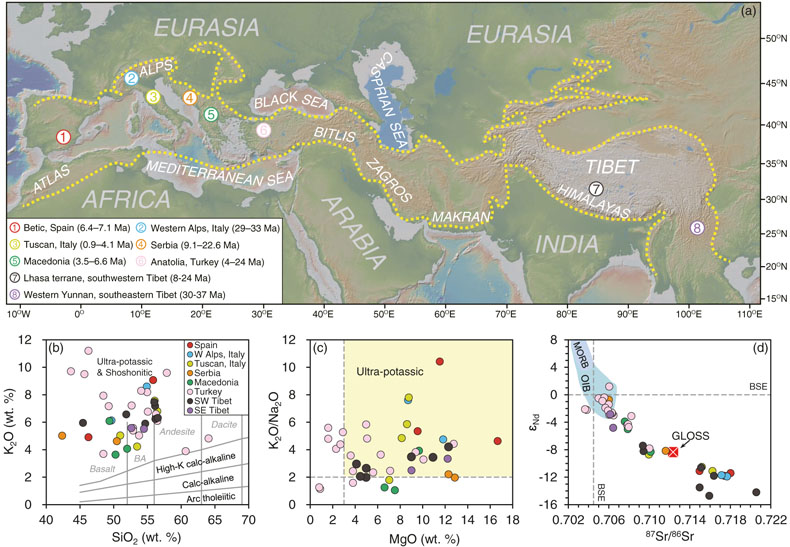
Figure 1 (a) Topographic map (http://www.geomapapp.org / CC BY) showing the region of Alpine-Himalayan orogenic belt (bounded by yellow dashed curves). Numbers in circles refer to the locations of K-rich volcanic rocks investigated in this study. (b) K2O vs. SiO2 diagram for classification of volcanic rocks (Peccerillo and Taylor, 1976
Peccerillo, A., Taylor, S. (1976) Geochemistry of Eocene calc-alkaline volcanic rocks from the Kastamonu area, northern Turkey. Contributions to Mineralogy and Petrology 58, 63–81.
). (c) K2O/Na2O vs. MgO. The ultra-potassic field is from Foley et al. (1987)Foley, S., Venturelli, G., Green, D., Toscani, L. (1987) The ultrapotassic rocks: characteristics, classification, and constraints for petrogenetic models. Earth-Science Reviews 24, 81–134.
. (d) ɛNd vs. 87Sr/86Sr. ɛNd and 87Sr/86Sr were calculated at the eruption age. The average global subducting sediments (GLOSS) is from Plank (2014)Plank, T. (2014) 4.17 – The chemical composition of subducting sediments. In: Holland, H.D., Turekian, K.K. (Eds.) Treatise on Geochemistry. Second Edition, Elsevier, Oxford, 607–629.
. Major element and Sr-Nd isotope data as well as corresponding references are provided in Table S-1.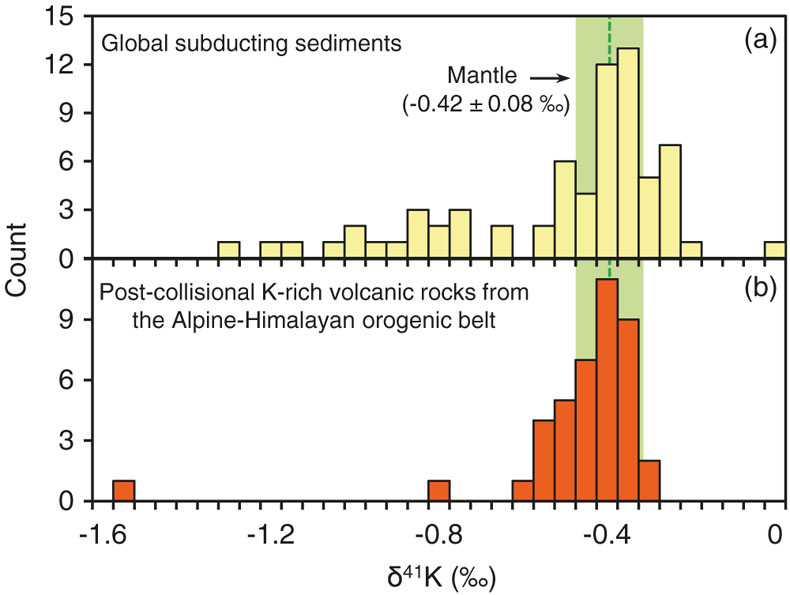
Figure 2 Comparison of δ41K between global subducting sediments (Hu et al., 2020
Hu, Y., Teng, F.-Z., Plank, T., Chauvel, C. (2020) Potassium isotopic heterogeneity in subducting oceanic plates. Science Advances 6, eabb2472.
) and K-rich volcanic rocks from the AHOB (this study). The mantle δ41K value (−0.42 ± 0.08 ‰) is from Hu et al. (2021a)Hu, Y., Teng, F.Z., Helz, R.T., Chauvel, C. (2021a) Potassium isotope fractionation during magmatic differentiation and the composition of the mantle. Journal of Geophysical Research: Solid Earth 126, e2020JB021543.
.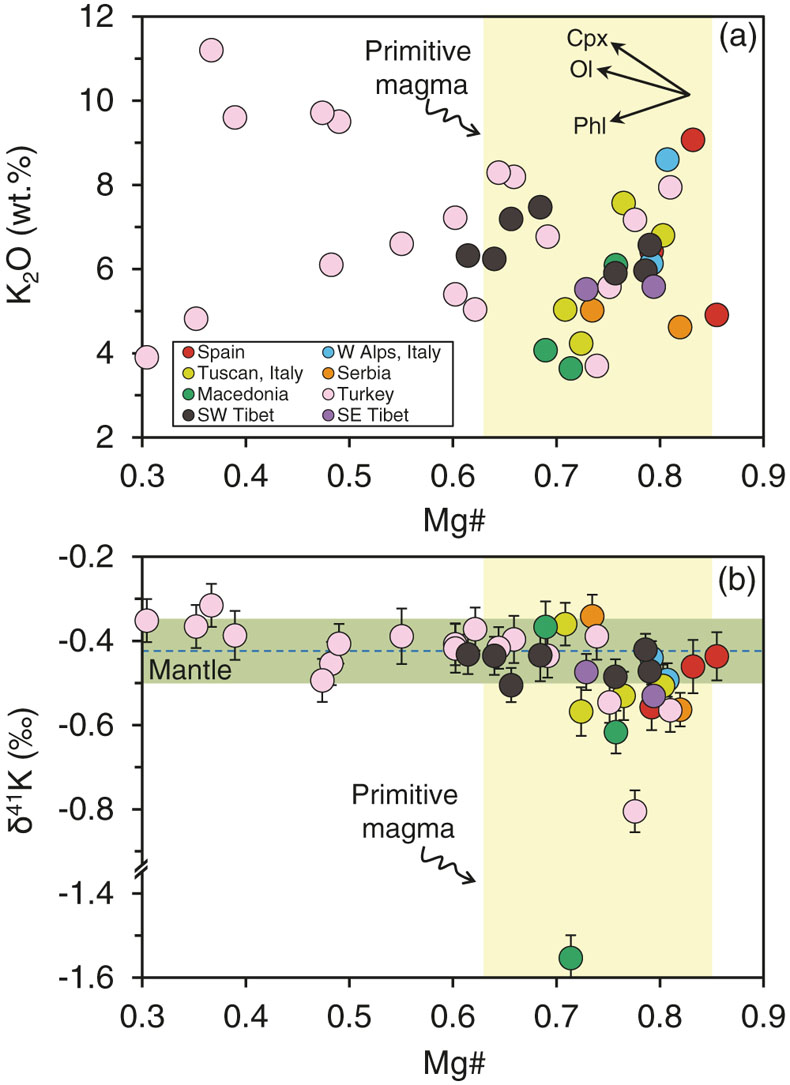
Figure 3 (a) K2O vs. Mg#. The vectors qualitatively indicate evolution of melts during fractional crystallisation of olivine (Ol), clinopyroxene (Cpx) and phlogopite (Phl). The yellow bar refers to the putative Mg# range (0.63–0.85) of primitive magmas, which was calculated based on the forsterite contents (85–95 %) of olivine phenocrysts in K-rich volcanic rocks from the AHOB (Prelević et al., 2013
Prelević, D., Jacob, D.E., Foley, S.F. (2013) Recycling plus: a new recipe for the formation of Alpine–Himalayan orogenic mantle lithosphere. Earth and Planetary Science Letters 362, 187–197.
) and the experimentally determined olivine-liquid Fe-Mg exchange coefficient ( = 0.3; Roeder and Emslie, 1970
= 0.3; Roeder and Emslie, 1970Roeder, P.L., Emslie, R. (1970) Olivine-liquid equilibrium. Contributions to Mineralogy and Petrology 29, 275–289.
). (b) δ41K vs. Mg#. The mantle δ41K (−0.42 ± 0.08 ‰) is from Hu et al. (2021a)Hu, Y., Teng, F.Z., Helz, R.T., Chauvel, C. (2021a) Potassium isotope fractionation during magmatic differentiation and the composition of the mantle. Journal of Geophysical Research: Solid Earth 126, e2020JB021543.
.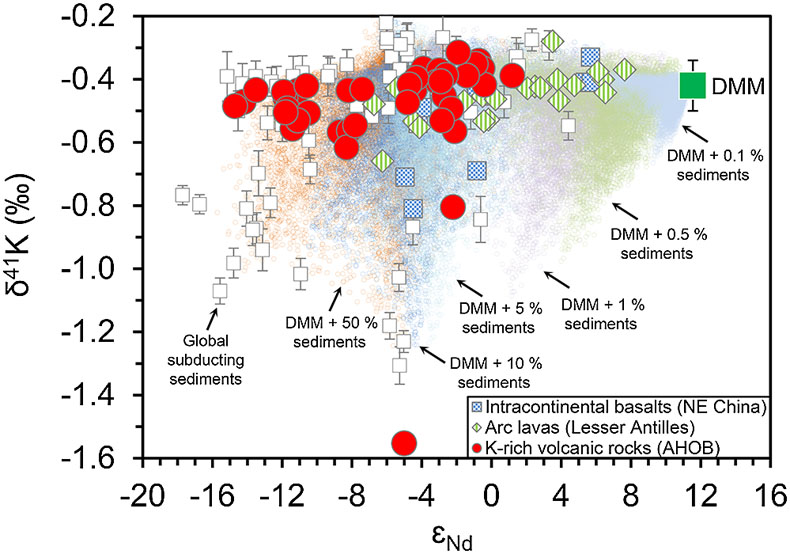
Figure 4 δ41K vs. ɛNd (calculated back at the eruption or depositional age). The δ41K and ɛNd of global subducting sediments are from Hu et al. (2020)
Hu, Y., Teng, F.-Z., Plank, T., Chauvel, C. (2020) Potassium isotopic heterogeneity in subducting oceanic plates. Science Advances 6, eabb2472.
and Plank (2014)Plank, T. (2014) 4.17 – The chemical composition of subducting sediments. In: Holland, H.D., Turekian, K.K. (Eds.) Treatise on Geochemistry. Second Edition, Elsevier, Oxford, 607–629.
. δ41K of the DMM is assumed to be the average mantle value and ɛNd of the DMM is from Workman and Hart (2005)Workman, R.K., Hart, S.R. (2005) Major and trace element composition of the depleted MORB mantle (DMM). Earth and Planetary Science Letters 231, 53–72.
. Small circles with different colours represent random mixing of subducted sediments with the DMM at variable proportions from a Monte Carlo simulation, of which the details are provided in the Supplementary Information.

